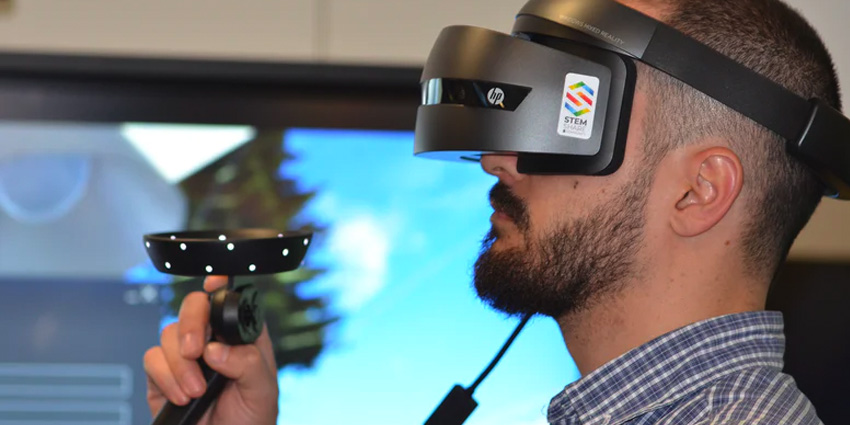Virtual reality (VR) caught the imagination of a generation from its foundation stages at the end of the last century up through Meta’s acquisition of Oculus; now, VR in business is becoming a serious consideration for many international firms.
There is a rise in consumer-grade headsets from firms like HTC, Meta, and Pico. Alongside the hardware rise, more smartphones are integrating augmented reality (AR) technology for social media applications. Immersive media’s rise means international audiences have ever-growing entry points.
Extended reality (XR) firms are working on enterprise-grade VR solutions and the required technology infrastructure for scalability. VR firms are designing tools that enhance team members’ training opportunities.
Innovative startups are exploring what might be possible in a future where VR technology is as commonplace as video conferencing.
The Surge Towards VR in Business
Some companies think VR could be the solution that bridges the gap between disparate employees in a hybrid environment. With VR and immersive real-time 3D (RT3D) collaboration applications, employees can work on shared projects in a virtual meeting room.
The benefit of using VR over video conferencing software is the core immersion. During 2D webcam meetings, employee engagement drops due to a disconnection between a dispersed workforce. Although immersive technology provides engaging features like avatars, RT3D graphics, and increased user expression to simulate a real-life interaction.
Additionally, most VR conferencing services, like ENAGE XR, Glue, and Virbela, enable inexperienced users to easily access integrated, immersive tools to boost a meeting situation.
VR in Business Colllaberation
In simple terms, VR brings a new level of immersion to the collaborative space. It goes beyond the value of video conferencing by allowing us to see things like body language and RT3D assets. VR also addresses growing problems in remote work, like Zoom or meeting fatigue.
VR can also boost live events, such as a virtual conference with keynote speakers presenting in an immersive space or performing virtual product demos. That may quickly seem like an everyday experience in the years to come.
Virtual Reality in Business is Growing
VR doesn’t just have benefits for collaboration. The technology could also change customer and client engagement. Clients could get a hands-on demonstration of workplace procedures in a virtual training environment with a specialist. VR training ensures a more immersive onboarding experience with safe, repeatable scenarios.
VR also has the potential to transform job training and staff development opportunities like never before. With VR, companies can place team members in settings they couldn’t safely or realistically replicate, such as an industrial environment, emergency service, and military training.
Significant brands are utilizing immersive VR to expand sales and outreach. NIKE is leveraging Roblox, an online Metavase-style platform aimed at children, to reach new audiences. The NiKELAND project also promotes children’s healthy lifestyles and encourages movement. NIKELAND debuted with a combination of competition and creativity to drive engagement using AR/VR technology.
Notably, the platform reached seven million members from roughly 223 countries. The service is free; users can enter the NIKELAND via a desktop or participate using a smartphone. A smartphone’s accelerometers and AR hardware provide the service’s interactive, immersive content.
@Nike came in at the No.2 spot because of their work in facilitating community events through Nike experiences, high energy score, and cutting-edge activations in the technology space, from the Nikeland Activation to your NFT shoe line. Congratulations! #MostInnovative pic.twitter.com/pXFBgAhMNG
— Sports Innovation Lab (@sportsilab) November 3, 2022
Workplace Comms and Client Interaction
An increasing number of VR collaboration platforms are emerging to enhance workplace communications. For example, Virbela is developing a Metaverse solution which creates a united culture across a virtual workplace. eXP Holdings is a core client of Virbela, with the company’s entire business operations taking place on the Metaverse service.
According to the CEO of Virbela, Alex Howland, eXp Holdings came to Virbela in 2016, the realty firm staffed around 1,000 agents at first, but it grew to “83,000 agents, all over the US and Canada.”
Recently, ENGAGE XR debuted its persistent business Metaverse LINK. The service offers clients virtual offices, venues, and environments hosted by connected “Metaworlds.” Major international cooperations joined ENGAGE LINK as launch partners, including KPMG US, KIA, Adtalem, and MTN Group.
Although VR’s business journey is not without its hurdles, in early 2022, when JP Morgan launched a Metaverse branch, many users expressed dissatisfaction with the experience.
Conversely, since JP Morgan’s lacklustre launch, other banking groups like HSBC and KEB Hana Bank have continued Web3/VR experiments.
Virtual Reality is Taking Off
Enterprise-grade VR opportunities are already here, emerging in various unique forms. Alongside the growth of immersive tech for consumers, the vast number of enterprise-focused VR firms, solutions, and products are outstanding.
The opportunities are endless, and the technology available to bring these new experiences to life is becoming more advanced and accessible. New headset solutions that are more lightweight, sophisticated, and have better developer support are leading immersive firms to provide better value to enterprise clients.
With VR’s development thanks to entertainment, consumer, enterprise and industry 4.0 funding, VR firms are also leveraging powerful technology like incredible image quality, cloud streaming, and haptics to create advanced VR services.
The future of VR in business is already emerging, and the world is excited to see what comes next.







